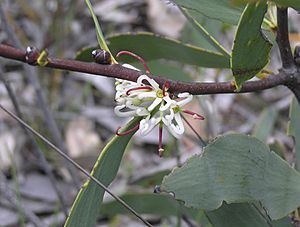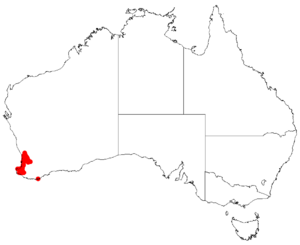Ram's horn facts for kids
Quick facts for kids Ramshorn hakea |
|
|---|---|
 |
|
| Hakea cyclocarpa growing near Mundaring Weir | |
| Scientific classification | |
| Genus: |
Hakea
|
| Species: |
cyclocarpa
|
 |
|
| Occurrence data from AVH | |
The Ramshorn hakea (Hakea cyclocarpa) is a special type of shrub. It's also known as the wild bean or curved-fruit hakea. This plant belongs to the Proteaceae family, which includes many unique Australian plants. It has a strong, pleasant smell and grows beautiful creamy-white flowers with a red center. You can find this interesting plant growing naturally along the west and southwest coasts of Western Australia.
Contents
What Does Ramshorn Hakea Look Like?
The Ramshorn hakea is a shrub that grows straight up. It can reach a height of about 1 to 2.5 meters (3 to 8 feet). Its bark is smooth and grey. Younger branches and new leaves are covered with soft, white, or rusty-colored hairs.
Flowers and Blooming Time
This plant produces clusters of 10 to 18 large flowers. These flowers are usually white or creamy-white. They have a distinctive red-brown part called a style, which is about 13-14 mm long. The flowers are covered in tiny, soft white hairs. The Ramshorn hakea blooms from August to October, making it a lovely sight in late winter and spring.
Leaves and Fruit
The leaves of the Ramshorn hakea can grow up to 17 cm (6.7 inches) long and 4 cm (1.6 inches) wide. They are shaped like a narrow egg, widest in the middle, and can be rounded or slightly pointed at the tip.
One of the most interesting parts of this plant is its fruit. The fruit is shaped like an "S" and looks a bit like a ram's horn, which is how the plant gets its common name. Each fruit is about 3.5 to 4 cm (1.4 to 1.6 inches) long and 1.8 to 2.2 cm (0.7 to 0.9 inches) wide. They are mostly smooth and have a small, pointed beak at the end.
How Was Ramshorn Hakea Named?
The Ramshorn hakea was first found by a botanist named James Drummond in 1839. A year later, in 1840, an English botanist named John Lindley officially described the species. He published his findings in a book called A Sketch of the Vegetation of the Swan River Colony.
Meaning of the Name cyclocarpa
The scientific name cyclocarpa comes from two Ancient Greek words. "Kyklos" means "circle," and "karpos" means "fruit." This name refers to the fruit's almost circular shape when viewed from certain angles.
Where Does Ramshorn Hakea Grow?
The Ramshorn hakea grows in Western Australia. You can find it from the Darling Range near Perth all the way south into the jarrah forests near Augusta.
Habitat and Growing Conditions
This plant is not very common, but it can grow in many different types of soil. It likes granite, laterite, loam, clay, sand, and gravelly soils. It thrives in open heathlands and forests. The Ramshorn hakea is a tough plant that can handle dry spells and frost. It prefers a spot with some shade and soil that drains water well.
Is Ramshorn Hakea Protected?
The Western Australian Government's Department of Parks and Wildlife currently considers the Ramshorn hakea to be "not threatened." This means it's not in danger of disappearing.

